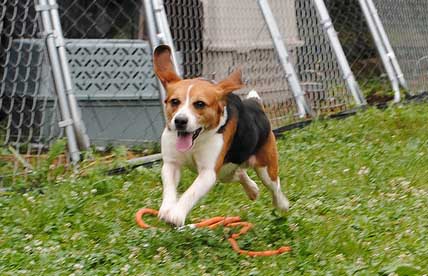New Life, Love for Rescued Monkeys and Beagles
More than 170 animals freed from bankrupt laboratory
 For years, they had no names; only numbers. But on July Fourth they became known Liberty and Star and Sparkle and the like as they celebrated their first true Independence Day.
For years, they had no names; only numbers. But on July Fourth they became known Liberty and Star and Sparkle and the like as they celebrated their first true Independence Day.
Until then, day after month after year, they’d lived in tiny plexiglass cages at a laboratory, Aniclin, in New Jersey. We may never know exactly what was done to them there – precisely which drugs and chemicals were being tried out on them – since Aniclin was a private lab, under no obligation to disclose its dark secrets. We do know that each of them lived alone – fed and kept clean, but with no life outside their cages.
Finally, mercifully, the morally bankrupt laboratory went financially bankrupt, too, and animal protection groups were called in to take possession of 118 beagles and 55 monkeys.
Most of the beagles went to Pets Alive, a sanctuary outside of New York City, where they’ve been cared by staff, volunteers and veterinarians. Many of them have already been adopted.
Everything about the day they were freed from the laboratory was a whole new experience. Seeing the sun … landing at Pets Alive in the middle of a heat wave … feeling grass under their paws … seeing lots of people … being hugged and cuddled. It was all new.
The beagles aren’t socialized or trained except for the care they’ve been getting since their rescue. But there has been enormous interest from people eager to provide homes. Less than two weeks after the rescue, 28 of the Pets Alive beagles, all spayed or neutered and with other medical needs (especially dental work) addressed had been adopted; 36 had been released to other rescue groups that will find them homes; and hundreds more people have applied to adopt the dogs. Just 24 were still in the temporary staging area awaiting adoption.
One personality quirk that their caregivers at Pets Alive have noted: At about 6 p.m. every day, they all bay in unison for a few seconds. That was probably the time the lights at the lab went out and the staff went home.
Among other groups involved, St Hubert’s took 30 of the beagles, and 30 more went to Best Friends Animal Sanctuary in Utah. Other rescue groups that took part included Sullivan County SPCA , Adopt A Dog, Save A Pet, Hudson Valley Humane, Second Chance Pet Adoption League, and the Ramapo-Bergen Animal Refuge.
Although the beagles were the majority of the animals, the more difficult situation was for the 55 monkeys – all long-tailed macaques. They couldn’t be adopted individually into people’s homes. In Defense of Animals took charge of them all, arranged for their care in sanctuaries across the country, and transported them to their new homes.
“These young monkeys would have been subjected to decades behind bars in cramped stainless steel cages, forced to endure painful toxicology tests” said IDA’s new president Scotlund Haisley. “Now they will have a life filled with fresh air, friends, and freedom from harm.”
One of the sanctuaries taking in the macaques is Mindy’s Memory Primate Sanctuary in Oklahoma, which is home to a dozen species of primates from around the world. They live in family groups with space to play and interact. The macaques will bring the total number of primates at Mindy’s Memory up to 86, all rejected pets and laboratory leftovers, many of whom will live into their 40s.
The other sanctuaries are all in Texas: Born Free USA, Wildlife Rescue and Rehabilitation, and Primarily Primates.
“Doing the right thing is not easy, and it’s not cheap,” said Robert Ingersoll president of the board of Mindy’s Memory. “Some of us decide to do it anyway.”
Before the rescue truck arrived, Mindy’s founder, Linda Barcklay, 70, was busy finishing last-minute work and mowing the lawn to give the macaques a special welcome.
Aniclin had been repeatedly cited by the U.S. Department of Agriculture for Animal Welfare Act violations. And since they had a license to sell monkeys, these 55 would like have ended up in other labs that routinely perform extremely invasive or terminal experiments on long-tailed macaques. Published articles from 2010 describe experimentation ranging from brain lesions, invasive brain studies of auditory, motor and visual cortex, Ebola virus, stroke, plague and drug-induced seizures. These intelligent, social primates often display clinical signs of depression and abnormal behavior including hair pulling, stereotypic circling and pacing, and even self-mutilation.
IDA says that the entire rescue was initiated by New York-based activist Camille Hankins, following an anonymous tip from a former animal caregiver at the recently closed lab, who was among a group of lab workers who, to their credit, scaled the fences to feed animals left behind after the lab fired the staff and locked its doors. After sometimes-tense negotiations with the company hired to liquidate the “assets” of the lab, a proposal to release the animals was accepted, with the crucial assistance of IDA pro bono attorney Kathryn Flood of the law firm Buchanan, Ingersoll & Rooney.
Other animal protection groups, including St. Hubert’s Animal Shelter in New Jersey, Win Animal Rights (W.A.R.) in New York City, and In Defense of Animals (IDA) in San Francisco helped push hard in legal proceedings to get the animals released and taken to safety. It all came together on July Fourth.
